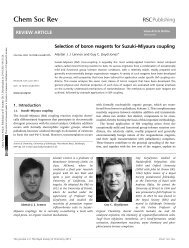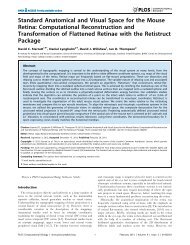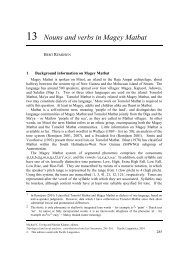Sturgeon fishing in the middle and lower Danube region László ...
Sturgeon fishing in the middle and lower Danube region László ...
Sturgeon fishing in the middle and lower Danube region László ...
Create successful ePaper yourself
Turn your PDF publications into a flip-book with our unique Google optimized e-Paper software.
<strong>László</strong> Bartosiewicz et al.: <strong>Sturgeon</strong> <strong>fish<strong>in</strong>g</strong> <strong>in</strong> <strong>the</strong> <strong>middle</strong> <strong>and</strong> <strong>lower</strong> <strong>Danube</strong> <strong>region</strong><br />
1. The sheets of dermal bone cover<strong>in</strong>g <strong>the</strong> head of<br />
Acipenserids tend to be numerous <strong>and</strong> irregular <strong>in</strong> shape to<br />
such an extent that <strong>the</strong>y may even be strongly asymmetric<br />
with<strong>in</strong> <strong>the</strong> same <strong>in</strong>dividual.<br />
2. While bones from large fish would more likely be recovered,<br />
<strong>the</strong>ir survival is poorest <strong>in</strong> old Acipenserids (especially<br />
beluga sturgeon), whose skeleton reabsorbs m<strong>in</strong>erals<br />
with <strong>the</strong> advancement of age. Thus, <strong>the</strong> largest bones<br />
tend to be most easily destroyed or eroded beyond recognition<br />
<strong>in</strong> archaeological deposits.<br />
Br<strong>in</strong>khuizen (1986) reviewed differences between <strong>the</strong> usually<br />
resistant <strong>and</strong> morphologically most characteristic dermal<br />
scutes of beluga <strong>and</strong> Russian sturgeons from <strong>the</strong> Iron Gates.<br />
The dorsal scutes of beluga sturgeon are oval <strong>in</strong> shape with an<br />
elongated, horn-like process. In mature <strong>in</strong>dividuals, <strong>the</strong>se<br />
scutes are covered by sk<strong>in</strong>. The lateral scutes of beluga sturgeon<br />
are too<strong>the</strong>d. In old <strong>in</strong>dividuals, <strong>the</strong>y are partially reabsorbed<br />
<strong>and</strong> develop a spongy, eroded look.<br />
The dorsal scutes of common <strong>and</strong> stellate sturgeon display<br />
a more marked morphological difference. These bones are<br />
almond-shaped with roof-like cross-sections. The medial<br />
1m<br />
Figure 5. <strong>Sturgeon</strong> species of major importance <strong>in</strong> <strong>the</strong> <strong>Danube</strong>, drawn to scale on <strong>the</strong> basis of mean lengths <strong>in</strong> Table 4<br />
(compiled <strong>and</strong> redrawn to scale after Ber<strong>in</strong>key 1967 <strong>and</strong> P<strong>in</strong>tér 1989).<br />
43<br />
edge of <strong>the</strong> ‘roof’ is largely symmetric <strong>in</strong> common sturgeon,<br />
while it is slightly skewed <strong>in</strong> a cranial direction <strong>in</strong> stellate<br />
sturgeon giv<strong>in</strong>g it a rose-thorn profile l<strong>in</strong>e. A strong radial<br />
pattern is also characteristic of stellate sturgeon. In o<strong>the</strong>r<br />
Danubian Acipenserids, even this character looks transitional<br />
between <strong>the</strong> two morphological extremes.<br />
It is chiefly large <strong>and</strong> compact dermal scutes with characteristic<br />
surface pattern<strong>in</strong>g that show up even <strong>in</strong> h<strong>and</strong>collected<br />
assemblages, which o<strong>the</strong>rwise conta<strong>in</strong> few fish rema<strong>in</strong>s.<br />
These scutes are arranged <strong>in</strong> dorsal, lateral <strong>and</strong> ventral<br />
rows along <strong>the</strong> body of sturgeons <strong>and</strong> differ both <strong>in</strong> size <strong>and</strong><br />
shape by anatomical location (Casteel 1976: 38, fig. 19).<br />
Accord<strong>in</strong>g to Ber<strong>in</strong>key (1966: 18–22), Vuković &<br />
Ivanović (1971: 106–112), P<strong>in</strong>tér (1989: 24–31) <strong>and</strong> a review<br />
of n<strong>in</strong>e authors by Br<strong>in</strong>khuizen (1989: 41), <strong>the</strong> number of<br />
dermal scutes <strong>and</strong> f<strong>in</strong> rays varies between <strong>the</strong> discussed species<br />
as shown <strong>in</strong> Table 5 <strong>and</strong> Figure 6. As is shown by <strong>the</strong>se<br />
data, dermal scutes not only form cont<strong>in</strong>uously chang<strong>in</strong>g<br />
rows on <strong>in</strong>dividuals of vary<strong>in</strong>g sizes, but also <strong>the</strong>ir numbers<br />
differ by species which makes <strong>the</strong>ir quantitative analysis a<br />
nightmarish enterprise.









